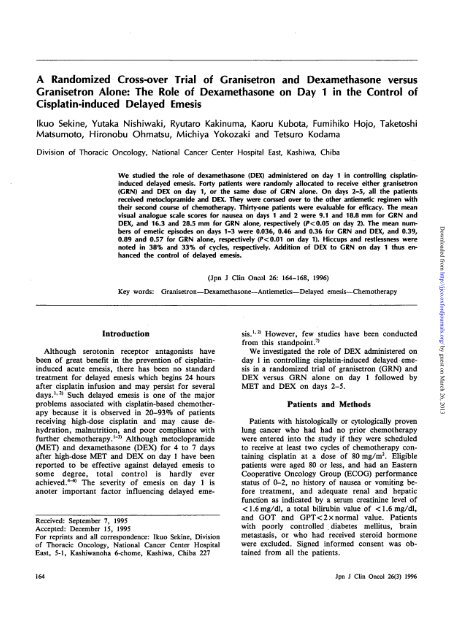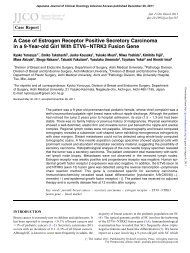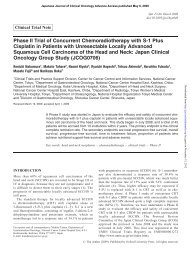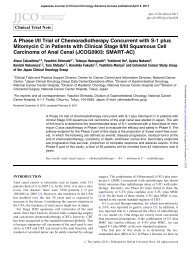A Randomized Cross-over Trial of Granisetron and Dexamethasone ...
A Randomized Cross-over Trial of Granisetron and Dexamethasone ...
A Randomized Cross-over Trial of Granisetron and Dexamethasone ...
You also want an ePaper? Increase the reach of your titles
YUMPU automatically turns print PDFs into web optimized ePapers that Google loves.
A <strong>R<strong>and</strong>omized</strong> <strong>Cross</strong>-<strong>over</strong> <strong>Trial</strong> <strong>of</strong> <strong>Granisetron</strong> <strong>and</strong> <strong>Dexamethasone</strong> versus<br />
<strong>Granisetron</strong> Alone: The Role <strong>of</strong> <strong>Dexamethasone</strong> on Day 1 in the Control <strong>of</strong><br />
Cisplatin-induced Delayed Emesis<br />
Ikuo Sekine, Yutaka Nishiwaki, Ryutaro Kakinuma, Kaoru Kubota, Fumihiko Hojo, Taketoshi<br />
Matsumoto, Hironobu Ohmatsu, Michiya Yokozaki <strong>and</strong> Tetsuro Kodama<br />
Division <strong>of</strong> Thoracic Oncology, National Cancer Center Hospital East, Kashiwa, Chiba<br />
We studied the role <strong>of</strong> dexamethasone (DEX) administered on day 1 in controlling cisplatininduced<br />
delayed emesis. Forty patients were r<strong>and</strong>omly allocated to receive either granisetron<br />
(GRN) <strong>and</strong> DEX on day 1, or the same dose <strong>of</strong> CRN alone. On days 2-5, all the patients<br />
received metoclopramide <strong>and</strong> DEX. They were corssed <strong>over</strong> to the other antiemetic regimen with<br />
their second course <strong>of</strong> chemotherapy. Thirty-one patients were evaluable for efficacy. The mean<br />
visual analogue scale scores for nausea on days 1 <strong>and</strong> 2 were 9.1 <strong>and</strong> 18.8 mm for GRN <strong>and</strong><br />
DEX, <strong>and</strong> 16.3 <strong>and</strong> 28.5 mm for GRN alone, respectively (P< 0.05 on day 2). The mean numbers<br />
<strong>of</strong> emetic episodes on days 1-3 were 0.036, 0.46 <strong>and</strong> 0.36 for GRN <strong>and</strong> DEX, <strong>and</strong> 0.39,<br />
0.89 <strong>and</strong> 0.57 for GRN alone, respectively (P2> Such delayed emesis is one <strong>of</strong> the major<br />
problems associated with cisplatin-based chemotherapy<br />
because it is observed in 20-93% <strong>of</strong> patients<br />
receiving high-dose cisplatin <strong>and</strong> may cause dehydration,<br />
malnutrition, <strong>and</strong> poor compliance with<br />
further chemotherapy. 1 " 31 Although metoclopramide<br />
(MET) <strong>and</strong> dexamethasone (DEX) for 4 to 7 days<br />
after high-dose MET <strong>and</strong> DEX on day 1 have been<br />
reported to be effective against delayed emesis to<br />
some degree, total control is hardly ever<br />
achieved.^ The severity <strong>of</strong> emesis on day 1 is<br />
anoter important factor influencing delayed erne-<br />
Received: September 7, 1995<br />
Accepted: December 15, 1995<br />
For reprints <strong>and</strong> all correspondence: Ikuo Sekine, Division<br />
<strong>of</strong> Thoracic Oncology, National Cancer Center Hospital<br />
East, 5-1, Kashiwanoha 6-chome, Kashiwa, Chiba 227<br />
sis. 1 ' 2) However, few studies have been conducted<br />
from this st<strong>and</strong>point. 7 '<br />
We investigated the role <strong>of</strong> DEX administered on<br />
day 1 in controlling cisplatin-induced delayed emesis<br />
in a r<strong>and</strong>omized trial <strong>of</strong> granisetron (GRN) <strong>and</strong><br />
DEX versus GRN alone on day 1 followed by<br />
MET <strong>and</strong> DEX on days 2-5.<br />
Patients <strong>and</strong> Methods<br />
Patients with histologically or cytologicaUy proven<br />
lung cancer who had had no prior chemotherapy<br />
were entered into the study if they were scheduled<br />
to receive at least two cycles <strong>of</strong> chemotherapy containing<br />
cisplatin at a dose <strong>of</strong> 80 mg/m 2 . Eligible<br />
patients were aged 80 or less, <strong>and</strong> had an Eastern<br />
Cooperative Oncology Group (ECOG) performance<br />
status <strong>of</strong> 0-2, no history <strong>of</strong> nausea or vomiting before<br />
treatment, <strong>and</strong> adequate renal <strong>and</strong> hepatic<br />
function as indicated by a serum creatinine level <strong>of</strong><br />
This study was a single-blind, r<strong>and</strong>omized, twoperiod<br />
two-treatment cross-<strong>over</strong> trial. Patients with<br />
non-small cell lung cancer received cisplatin<br />
[80 mg/m 2 intravenously (i.v.)] on day 1, <strong>and</strong><br />
vindesine (3 mg/m 2 i.v.) on days 1 <strong>and</strong> 8, with or<br />
without mitomycin C (8 mg/m 2 i.v.) on day 1.<br />
Those with small cell lung cancer received cisplatin<br />
(80 mg/m 2 i.v.) on day 1, <strong>and</strong> etoposide<br />
(100 mg/m 2 i.v.) on days 1-3. Cisplatin was administered<br />
by 1-h drip infusion with 2.5 to 3 liters<br />
<strong>of</strong> hydration.<br />
Patients were r<strong>and</strong>omly assigned to receive either<br />
GRN + DEX: GRN (40/tg/kg) diluted in 100 ml <strong>of</strong><br />
normal saline given i.v. 30 min before 4 h after<br />
cisplatin infusion, <strong>and</strong> DEX (16 mg i.v.) 30 min before<br />
cisplatin infusion, or GRN alone at the same<br />
doses as those described above. The two fixed<br />
doses <strong>of</strong> granisetron were administered to all patients<br />
to avoid any influence <strong>of</strong> differing drug<br />
doses. All patients were given MET (40 mg) diluted<br />
in 100 ml <strong>of</strong> normal saline i.v. <strong>over</strong> 30 min<br />
twice daily on days 2-5, <strong>and</strong> DEX (8 mg i.v. on<br />
days 2 <strong>and</strong> 3, <strong>and</strong> 4 mg on days 4 <strong>and</strong> 5). They<br />
were crossed <strong>over</strong> to the other antiemetic regimen<br />
on their second course <strong>of</strong> chemotherapy.<br />
All patients were requested to record the severity<br />
<strong>of</strong> nausea using a graded scale (none, mild,<br />
moderate, or severe) <strong>and</strong> a visual-analogue scale<br />
(VAS; 0 = no nausea, 100 = intolerable nausea), the<br />
number <strong>of</strong> episodes <strong>of</strong> vomiting, <strong>and</strong> side effects<br />
on a diary card on days 1-5. Complete response<br />
(CR) was defined as absence <strong>of</strong> vomiting episodes<br />
<strong>and</strong> none on the graded scale <strong>of</strong> nausea.<br />
Patients were considered evaluable for efficacy if<br />
they received both courses <strong>of</strong> antiemetic therapies.<br />
Mean values <strong>of</strong> VAS for nausea <strong>and</strong> the number <strong>of</strong><br />
emetic episodes for each <strong>of</strong> the two regimens were<br />
calculated. The sample size was determined on the<br />
assumption that the CR rate on day 2 for GRN<br />
alone <strong>and</strong> that for GRN + DEX were 20 <strong>and</strong> 40%,<br />
respectively. With a power (1-6) <strong>of</strong> 80%, the estimated<br />
required sample size was 40 patients. 8 ' The<br />
cross-<strong>over</strong> difference (the difference between the<br />
two regimens) <strong>and</strong> its statistical signficance was examined<br />
by the Hills-Armitage method, which is<br />
based on Student's t test. The statistical significance<br />
<strong>of</strong> patient preference was examined by McNemar's<br />
test. 9 '<br />
Results<br />
Between May 1993 <strong>and</strong> April 1994, 40 patients<br />
were entered into the study. Nine patients were not<br />
evaluable for efficacy. One <strong>of</strong> them could not be<br />
given DEX because <strong>of</strong> aggravation <strong>of</strong> diabetes mellitus.<br />
The other 8 patients received only one course<br />
<strong>of</strong> chemotherapy: seven because <strong>of</strong> disease progres-<br />
DEXAMETHASONE FOR DELAYED EMESIS<br />
Table I. Characteristics <strong>of</strong> Evaluable Patients<br />
Characteristics<br />
GRN + DEX<br />
then<br />
GRN alone<br />
Number <strong>of</strong> patients 16<br />
Median age (range) 56.5 (39-71)<br />
Male/Female<br />
10/6<br />
Chemotherapy regimens<br />
cisplatin + vindesine<br />
cisplatin + vindesine +<br />
8<br />
mitomycin C<br />
7<br />
cisplatin + etoposide 1<br />
GRN alone<br />
then<br />
GRN + DEX<br />
15<br />
65.0 (22-77)<br />
10/5<br />
sion, <strong>and</strong> one because <strong>of</strong> impaired renal function.<br />
The characteristics <strong>of</strong> 31 evaluable patients who<br />
completed both courses <strong>of</strong> antiemetic therapy are<br />
summarized in Table I. There was significant difference<br />
between the two antiemetic treatment groups.<br />
Of the 31 patients, 26 were fully evaluable. Two<br />
patients were evaluable only for the number <strong>of</strong><br />
emetic episodes from their medical records because<br />
their diary cards were lost. The other 3 patients<br />
were included only in the assessment <strong>of</strong> the CR<br />
rate, because they were unable to fill out their<br />
diary cards due to severe vomiting.<br />
Nausea was assessed in 26 patients. As shown in<br />
Fig. 1, the VAS scores on days 1 <strong>and</strong> 2 for<br />
GRN + DEX were lower than those for "GRN alone,<br />
though statistical significance was obtained only on<br />
day 2 (P
30<br />
25<br />
•a 20<br />
3<br />
GRN+DEX<br />
GRN alone<br />
SEKINE ET AL.<br />
Dayl Day 2 Day 3 Day 4 Day 5 Dayl Day 2 Day 3 Day 4, Day 5<br />
Fig. 1. Severity <strong>of</strong> nausea on days 1-5 assessed by the<br />
visual-analogue scale, VAS (n 26). The VAS scores on days<br />
1 <strong>and</strong> 2 for GRN + DEX were lower than those for GRN<br />
alone, respectively (/>
therapy/ 1 ** There is contr<strong>over</strong>sy about the efficacy<br />
<strong>of</strong> DEX combined with a 5-HT3 receptor antagonist<br />
for delayed emesis. A r<strong>and</strong>omized trial<br />
comparing tropisetron monotherapy on days 1-6<br />
with a combination <strong>of</strong> tropisetron <strong>and</strong> DEX on<br />
days 1-6 showed that significantly more patients in<br />
the latter arm were free <strong>of</strong> delayed nausea or<br />
vomiting, 10 ' whereas a comparison <strong>of</strong> a combination<br />
<strong>of</strong> GRN <strong>and</strong> DEX for 6 days with one <strong>of</strong><br />
MET <strong>and</strong> DEX for 6 days showed that patients<br />
treated with the latter combination had a tendency<br />
to suffer more episodes <strong>of</strong> vomiting. 11 ' Another<br />
important factor in controlling delayed emesis is the<br />
degree <strong>of</strong> acute emesis, though the mechanism is<br />
not fully understood. 1 ' 2) Thus, delayed emesis is<br />
not an isolated pehnomenon <strong>and</strong> should be studied<br />
in conjunction with antiemetic therapy in the acute<br />
<strong>and</strong> delayed phases.<br />
This study showed that DEX administered on<br />
day 1 enhanced the control <strong>of</strong> nausea <strong>and</strong> vomiting<br />
on day 2 as well as that on day 1. This result<br />
is consistent with that <strong>of</strong> a r<strong>and</strong>omized trial <strong>of</strong><br />
OND <strong>and</strong> DEX versus high-dose MET, DEX, <strong>and</strong><br />
diphenhydramine on day 1 with MET <strong>and</strong> DEX on<br />
days 2-5, which also showed better control on day<br />
2 in the OND <strong>and</strong> DEX arm. 7) In addition, the<br />
present results suggest that early use <strong>of</strong> DEX may<br />
contribute to prevention <strong>of</strong> delayed emesis.<br />
The mean number <strong>of</strong> vomiting episodes on day<br />
2 did not differ significantly between the treatments.<br />
The power was calculated at 30% from the<br />
true difference in the treatments, 0.428, <strong>and</strong> the<br />
st<strong>and</strong>ard error, 0.27, suggesting that the number <strong>of</strong><br />
patients was too small for a difference to be<br />
demonstrated. 8 ' However, we discontinued the trial<br />
because a significant difference was observed in the<br />
mean number <strong>of</strong> vomiting episodes on day 1 <strong>and</strong><br />
in the VAS score on day 2.<br />
In this trial, one fourth <strong>of</strong> the patients refused to<br />
receive MET because <strong>of</strong> severe hiccups <strong>and</strong>/or restlessness.<br />
Repeated administration <strong>of</strong> MET seemed<br />
to increase the incidence <strong>and</strong> severity <strong>of</strong> these symptoms.<br />
Other effects were mild <strong>and</strong> self-limiting.<br />
Although a cross-<strong>over</strong> design has been commonly<br />
applied in trials <strong>of</strong> antiemetic drugs, 12 ' its limitation<br />
are also well recognized. 9 ' First, drop-outs<br />
tend to occur frquently, especially in trials <strong>of</strong><br />
chemotherapy for non-small cell lung cancer because<br />
<strong>of</strong> the low response rate. In this trial, 9<br />
(23%) <strong>of</strong> 40 patients were excluded from the evaluation<br />
<strong>of</strong> efficacy. The second problem is the unstable<br />
condition <strong>of</strong> patients with cancer. We excluded<br />
patients who had poor performance status, short<br />
life expectancy, or any condition which may have<br />
caused nausea <strong>and</strong> vomiting, consciousness disturbance,<br />
or alteration <strong>of</strong> mental status. Third, we<br />
should consider carry-<strong>over</strong> effect in trials <strong>of</strong> anti-<br />
DEXAMETHASONE FOR DELAYED EMESIS<br />
emetic agents because the psychological status induced<br />
by the first treatment may influence outcome.<br />
Testing for a carry-<strong>over</strong> effect using patient<br />
totals showed no evidence <strong>of</strong> such an effect in the<br />
number <strong>of</strong> vomiting episodes on day 1 or in the<br />
VAS score on day 2." However, a cross-<strong>over</strong> design<br />
should be considerably advantageous in trials<br />
<strong>of</strong> delayed emesis, because fewer patients are required<br />
to obtain the same degree <strong>of</strong> precision as a<br />
result <strong>of</strong> elimination <strong>of</strong> inter-patient variation. 8 '<br />
Otherwise, many patients would be required before<br />
phase III studies could establish a st<strong>and</strong>ard<br />
treatment.<br />
In conclusion, addition <strong>of</strong> DEX to GRN on day<br />
1 was <strong>of</strong> great benefit for the control <strong>of</strong> nausea on<br />
day 2. Although the regimen <strong>of</strong> GRN + DEX on<br />
day 1 with MET + DEX on days 2-5 was well<br />
tolerated <strong>and</strong> highly effective on day 1, antiemetic<br />
efficacy in the delayed phase was hot satisfactory.<br />
Further trials <strong>of</strong> delayed emesis is conjunction with<br />
acutue <strong>and</strong> delayed antiemetic regimens are warranted.<br />
Acknowledgments<br />
This study was supportd in part by Grants-in-Aid for<br />
Cancer Research (5S-1) from the Ministry <strong>of</strong> Health <strong>and</strong><br />
Welfare, Japan.<br />
References<br />
1) Del Favero A, Roila F, Tonato M: Reducing<br />
chemotherapy-induced nausea <strong>and</strong> vomiting: current<br />
perspectives <strong>and</strong> future possibilities. Drug Safety 9:<br />
410-428, 1993<br />
2) Gralla RJ: Antiemetic therapy. In Cancer: Principles<br />
& Practice <strong>of</strong> Oncology, 4th ed, DeVita VT, Hellman<br />
S, Rosenberg SA, eds, JB Lippincott Co, Philadelphia.<br />
p2338-2348, 1993<br />
3) Kris MG, Gralla RJ, Clark RA, Tyson LB,<br />
O'Connell JP, Wertheim MS, Kelsen DP: Incidence,<br />
course, <strong>and</strong> severity <strong>of</strong> delayed nausea <strong>and</strong> vomiting<br />
following the administration <strong>of</strong> high-dose cisplatin. J<br />
Clin Oncol 3: 1379-1384, 1985<br />
4) Shinkai T, Saijo N, Eguchi K, Sasaki Y, Tamura T,<br />
Fujiwara Y, Mae M, Fukuda M, Ohe Y, Sasaki S,<br />
Nakagawa K, Minato K, Hong WS, Suemasu K:<br />
Control <strong>of</strong> cisplatin-induced delayed emesis with<br />
metoclopramide <strong>and</strong> dexamethasone: a r<strong>and</strong>omized<br />
controlled trial. Jpn J Clin Oncol 19: 40-44, 1989<br />
5) Kris MG, Gralla RJ, Tyson LB, Clark RA,<br />
Cirrincione C, Groshen S: Controlling delayed vomiting:<br />
double-blind, r<strong>and</strong>omized trial comparing placebo,<br />
dexamethasone alone, <strong>and</strong> metoclopramide plus<br />
dexamethasone in patients receiving cisplatin. J Clin<br />
Oncol 7: 108-114, 1989<br />
6) Moreno I, Rosell R, Abad A, Barnadas A, Carles J,<br />
Ribelles N, Solano V, Font A: Comparison <strong>of</strong> three<br />
protracted antiemetic regimens for the control <strong>of</strong><br />
167<br />
Downloaded from<br />
http://jjco.oxfordjournals.org/ by guest on March 26, 2013
delayed emesis in cisplatin-treated patients. Eur J<br />
Cancer 28A: 1344-1347, 1992<br />
7) Italian Group for Antiemetic Research: Ondansetron<br />
+ dexamethasone vs metoclopramide + dexamethasone<br />
+ diphenhydramine in prevention <strong>of</strong> cisplatininduced<br />
emesis. Lancet 340: 96-99, 1992<br />
8) Hills M, Armitage P: The two-period cross-<strong>over</strong> clinical<br />
trial. Br J Clin Pharmac 8: 7-20, 1979<br />
9) Senn S: <strong>Cross</strong>-<strong>over</strong> <strong>Trial</strong>s in Clinical Research. John<br />
Wiley & Sons Ltd, Chichester. 1993<br />
10) Sorbe B, Hogberg T, Himmelmann A, Schmidt M,<br />
Raisanen I, Stockmeyer M, de Bruijn KM: Efficacy<br />
<strong>and</strong> tolerability <strong>of</strong> tropisetron in comparison with a<br />
combination <strong>of</strong> tropisetron <strong>and</strong> dexamethasone in<br />
SEKINE ET AL.<br />
the control <strong>of</strong> nausea <strong>and</strong> vomiting induced by<br />
cisplatin-containing chemotherapy. Eur J Cancer 30A:<br />
629-634, 1994<br />
11) Ohmatsu H, Eguchi K, Shinkai T, Tamura T, Ohe<br />
Y, Nisio M, Kunikane H, Arioka H, Karato A,<br />
Nakashima H, Sasaki Y, Tajima K, Tada N, Saijo<br />
N: A r<strong>and</strong>omized cross-<strong>over</strong> study <strong>of</strong> high-dose<br />
metoclopramide plus dexamethasone versus granisetron<br />
plus dexamethasone in patients receiving<br />
chemotherapy with high-dose cisplatin. Jpn J Cancer<br />
Res 85: 1151-1158, 1994<br />
12) Bakowski MT: Advances in anti-emetic therapy.<br />
Cancer Treat Rev 11: 237-256, 1984<br />
168 Jpn J Clin Oncol 26(3) 1996<br />
Downloaded from<br />
http://jjco.oxfordjournals.org/ by guest on March 26, 2013







